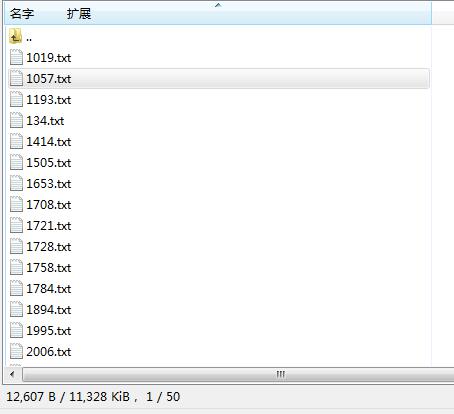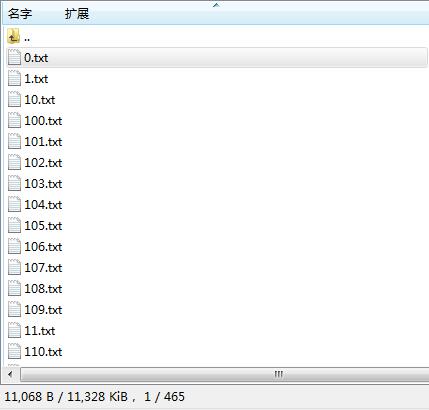本文例子基于mahout0.11.2,在mahout-examples中有一个脚本bin/cluster-reuters.sh通过调用mahout命令来对内容进行聚类分析,其中kmeans算法的调用步骤如下
#把内容转成hadoop的序列文件
$MAHOUT seqdirectory -i ${WORK_DIR}/reuters-out -o ${WORK_DIR}/reuters-out-seqdir -c UTF-8 -chunk 64 -xm sequential
#把文本向量化
$MAHOUT seq2sparse \
-i ${WORK_DIR}/reuters-out-seqdir/ \
-o ${WORK_DIR}/reuters-out-seqdir-sparse-kmeans --maxDFPercent 85 --namedVector \
#调用kmeans算法对文章进行聚类
$MAHOUT kmeans \
-i ${WORK_DIR}/reuters-out-seqdir-sparse-kmeans/tfidf-vectors/ \
-c ${WORK_DIR}/reuters-kmeans-clusters \
-o ${WORK_DIR}/reuters-kmeans \
-dm org.apache.mahout.common.distance.EuclideanDistanceMeasure \
-x 10 -k 20 -ow --clustering \
#分析最后聚类的输出结果
$MAHOUT clusterdump \
-i `$DFS -ls -d ${WORK_DIR}/reuters-kmeans/clusters-*-final | awk '{print $8}'` \
-o ${WORK_DIR}/reuters-kmeans/clusterdump \
-d ${WORK_DIR}/reuters-out-seqdir-sparse-kmeans/dictionary.file-0 \
-dt sequencefile -b 100 -n 20 --evaluate -dm org.apache.mahout.common.distance.EuclideanDistanceMeasure -sp 0 \
--pointsDir ${WORK_DIR}/reuters-kmeans/clusteredPoints \
&& \
cat ${WORK_DIR}/reuters-kmeans/clusterdump在mahout-0.11.2\src\conf\driver.classes.default.props该文件记录了mahout所有调用命令对应的java处理类
org.apache.mahout.text.SequenceFilesFromDirectory //把内容转成hadoop的序列文件
org.apache.mahout.vectorizer.SparseVectorsFromSequenceFiles //把文本向量化
org.apache.mahout.clustering.kmeans.KMeansDriver //kmeans算法实现类
org.apache.mahout.clustering.canopy.CanopyDriver //canopy算法实现类mahout-examples项目有kmeans和canopy的例子代码
org\apache\mahout\clustering\syntheticcontrol\canopy\Job.java
org\apache\mahout\clustering\syntheticcontrol\kmeans\Job.java下面通过代码实现对网上收集的3000多篇文章的进行聚类分析:
1、文本内容都是中文为主,在序列化文件化时,使用了jcseg分词,同时过滤掉一些不必要的内容,并以空格分隔来保存分词结果;
2、kmeans需要提前确定簇个数,如果簇的个数不准确,会影响聚类结果的准确度,可以使用canopy+kmeans的方式来分析文章
package com.mahout.penngo;
import java.io.BufferedReader;
import java.io.BufferedWriter;
import java.io.File;
import java.io.FileReader;
import java.io.FileWriter;
import java.io.IOException;
import java.io.StringReader;
import java.util.HashMap;
import java.util.Iterator;
import java.util.List;
import java.util.Map;
import java.util.Set;
import java.util.Map.Entry;
import org.apache.hadoop.conf.Configuration;
import org.apache.hadoop.fs.FileSystem;
import org.apache.hadoop.fs.Path;
import org.apache.hadoop.io.IntWritable;
import org.apache.hadoop.io.SequenceFile;
import org.apache.lucene.analysis.Analyzer;
import org.apache.lucene.analysis.core.WhitespaceAnalyzer;
import org.apache.mahout.clustering.Cluster;
import org.apache.mahout.clustering.canopy.CanopyDriver;
import org.apache.mahout.clustering.classify.WeightedPropertyVectorWritable;
import org.apache.mahout.clustering.kmeans.KMeansDriver;
import org.apache.mahout.clustering.kmeans.RandomSeedGenerator;
import org.apache.mahout.common.HadoopUtil;
import org.apache.mahout.common.Pair;
import org.apache.mahout.common.distance.DistanceMeasure;
import org.apache.mahout.common.distance.EuclideanDistanceMeasure;
import org.apache.mahout.math.NamedVector;
import org.apache.mahout.math.hadoop.stats.BasicStats;
import org.apache.mahout.utils.io.ChunkedWriter;
import org.apache.mahout.vectorizer.DictionaryVectorizer;
import org.apache.mahout.vectorizer.DocumentProcessor;
import org.apache.mahout.vectorizer.HighDFWordsPruner;
import org.apache.mahout.vectorizer.collocations.llr.LLRReducer;
import org.apache.mahout.vectorizer.common.PartialVectorMerger;
import org.apache.mahout.vectorizer.tfidf.TFIDFConverter;
import org.json.simple.JSONObject;
import org.json.simple.JSONValue;
import org.lionsoul.jcseg.tokenizer.ASegment;
import org.lionsoul.jcseg.tokenizer.core.ADictionary;
import org.lionsoul.jcseg.tokenizer.core.DictionaryFactory;
import org.lionsoul.jcseg.tokenizer.core.IWord;
import org.lionsoul.jcseg.tokenizer.core.JcsegTaskConfig;
import org.lionsoul.jcseg.tokenizer.core.SegmentFactory;
import com.google.common.io.Closeables;
public class NewsInfo {
private Configuration conf = null;
private FileSystem fs = null;
private String dataFile;
public String outputPath;
public final static String seqdirectoryPath = "seqdirectory";
public final static String seq2sparsePath = "seq2sparse";
public final static String kmeansPath = "kmeans";
public final static String canopyPath = "canopy";
public final static String canopyKmeansPath = "canopy_kmeans";
public NewsInfo(String i, String o) throws Exception {
this.dataFile = i;
this.outputPath = o;
conf = new Configuration();
fs = FileSystem.get(conf);
}
/**
* 把指定 输入的内容转成hadoop的序列文件
*/
public void seqdirectory() {
try {
JcsegTaskConfig config = new JcsegTaskConfig();
ADictionary dic = DictionaryFactory.createDefaultDictionary(config);
ASegment seg = (ASegment) SegmentFactory.createJcseg(
JcsegTaskConfig.COMPLEX_MODE, new Object[] { config, dic });
Path outputDir = new Path(outputPath, seqdirectoryPath);
fs.deleteOnExit(outputDir);
fs.mkdirs(outputDir);
ChunkedWriter writer = new ChunkedWriter(conf, 64, outputDir);
FileReader fr = new FileReader(dataFile);
BufferedReader br = new BufferedReader(fr);
String line = null;
while ((line = br.readLine()) != null) {
JSONObject json = (JSONObject) JSONValue.parse(line);
String id = json.get("id").toString();
String title = json.get("title").toString();
String content = json.get("content").toString();
seg.reset(new StringReader(title + " " + content));
IWord word = null;
StringBuffer sr = new StringBuffer();
while ((word = seg.next()) != null) {
String type = word.getPartSpeech() != null ? word
.getPartSpeech()[0] : "";
if (type.startsWith("w") == false) {
sr.append(word.getValue()).append(" ");
}
}
writer.write(id, sr.toString());
}
Closeables.close(writer, false);
br.close();
fr.close();
} catch (Exception e) {
e.printStackTrace();
}
}
/**
* 把文本内容向量化
*/
public void seq2sparse(){
try {
Path inputDir = new Path(this.outputPath, this.seqdirectoryPath);
Path outputDir = new Path(this.outputPath, this.seq2sparsePath);
int chunkSize = 100;
int minSupport = 2;
int maxNGramSize = 1;
float minLLRValue = LLRReducer.DEFAULT_MIN_LLR;
int reduceTasks = 1;
Class<? extends Analyzer> analyzerClass = WhitespaceAnalyzer.class;//StandardAnalyzer.class;
boolean processIdf = true;
int minDf = 1;
int maxDFPercent = 99;
double maxDFSigma = -1.0;
float norm = PartialVectorMerger.NO_NORMALIZING;
boolean logNormalize = false;
Path tokenizedPath = new Path(outputDir, DocumentProcessor.TOKENIZED_DOCUMENT_OUTPUT_FOLDER);
DocumentProcessor.tokenizeDocuments(inputDir, analyzerClass, tokenizedPath, conf);
boolean sequentialAccessOutput = true;
boolean namedVectors = true;
boolean shouldPrune = maxDFSigma >= 0.0 || maxDFPercent > 0.00;
String tfDirName = shouldPrune
? DictionaryVectorizer.DOCUMENT_VECTOR_OUTPUT_FOLDER + "-toprune"
: DictionaryVectorizer.DOCUMENT_VECTOR_OUTPUT_FOLDER;
if (processIdf) {
DictionaryVectorizer.createTermFrequencyVectors(tokenizedPath,
outputDir,
tfDirName,
conf,
minSupport,
maxNGramSize,
minLLRValue,
-1.0f,
false,
reduceTasks,
chunkSize,
sequentialAccessOutput,
namedVectors);
} else {
DictionaryVectorizer.createTermFrequencyVectors(tokenizedPath,
outputDir,
tfDirName,
conf,
minSupport,
maxNGramSize,
minLLRValue,
norm,
logNormalize,
reduceTasks,
chunkSize,
sequentialAccessOutput,
namedVectors);
}
Pair<Long[], List<Path>> docFrequenciesFeatures = null;
if (shouldPrune || processIdf) {
docFrequenciesFeatures =
TFIDFConverter.calculateDF(new Path(outputDir, tfDirName), outputDir, conf, chunkSize);
}
long maxDF = maxDFPercent; //if we are pruning by std dev, then this will get changed
if (shouldPrune) {
long vectorCount = docFrequenciesFeatures.getFirst()[1];
if (maxDFSigma >= 0.0) {
Path dfDir = new Path(outputDir, TFIDFConverter.WORDCOUNT_OUTPUT_FOLDER);
Path stdCalcDir = new Path(outputDir, HighDFWordsPruner.STD_CALC_DIR);
// Calculate the standard deviation
double stdDev = BasicStats.stdDevForGivenMean(dfDir, stdCalcDir, 0.0, conf);
maxDF = (int) (100.0 * maxDFSigma * stdDev / vectorCount);
}
long maxDFThreshold = (long) (vectorCount * (maxDF / 100.0f));
// Prune the term frequency vectors
Path tfDir = new Path(outputDir, tfDirName);
Path prunedTFDir = new Path(outputDir, DictionaryVectorizer.DOCUMENT_VECTOR_OUTPUT_FOLDER);
Path prunedPartialTFDir =
new Path(outputDir, DictionaryVectorizer.DOCUMENT_VECTOR_OUTPUT_FOLDER + "-partial");
// log.info("Pruning");
if (processIdf) {
HighDFWordsPruner.pruneVectors(tfDir,
prunedTFDir,
prunedPartialTFDir,
maxDFThreshold,
minDf,
conf,
docFrequenciesFeatures,
-1.0f,
false,
reduceTasks);
} else {
HighDFWordsPruner.pruneVectors(tfDir,
prunedTFDir,
prunedPartialTFDir,
maxDFThreshold,
minDf,
conf,
docFrequenciesFeatures,
norm,
logNormalize,
reduceTasks);
}
HadoopUtil.delete(new Configuration(conf), tfDir);
}
if (processIdf) {
TFIDFConverter.processTfIdf(
new Path(outputDir, DictionaryVectorizer.DOCUMENT_VECTOR_OUTPUT_FOLDER),
outputDir, conf, docFrequenciesFeatures, minDf, maxDF, norm, logNormalize,
sequentialAccessOutput, namedVectors, reduceTasks);
}
} catch (Exception e) {
e.printStackTrace();
}
}
/**
* kmeans聚类分析文本
*/
public void kmeans(){
try{
int k = 50;
int maxIterations = 10;
double convergenceDelta = 0.01;
DistanceMeasure measure = new EuclideanDistanceMeasure();
Path initialPoints = new Path(this.outputPath, "random-seeds");
fs.deleteOnExit(initialPoints);
Path input = new Path(this.outputPath + "/" + this.seq2sparsePath, "tfidf-vectors");
Path output = new Path(this.outputPath, this.kmeansPath);
fs.deleteOnExit(output);
RandomSeedGenerator.buildRandom(conf, input, initialPoints, k, measure, 1L);
KMeansDriver.run(conf, input, initialPoints, output, convergenceDelta,
maxIterations, true, 0.0, false);
// run ClusterDumper
// Path outGlob = new Path(output, "clusters-*-final");
// Path clusteredPoints = new Path(output,"clusteredPoints");
// ClusterDumper clusterDumper = new ClusterDumper(outGlob, clusteredPoints);
// clusterDumper.printClusters(null);
}
catch(Exception e){
e.printStackTrace();
}
}
/**
* 读取聚类分析结果
* @param input
* @param output
* @param gFile
*/
public void clusterResult(String input, String output, String gFile) {
String file = this.outputPath + "/" + input;
String txtFile = this.outputPath + "/" + output;
String groupFile = this.outputPath + "/" + gFile;
try {
BufferedWriter bw;
Configuration conf = new Configuration();
// conf.set("fs.default.name", "hdfs://baby6:31054");
FileSystem fs = FileSystem.get(conf);
SequenceFile.Reader reader = null;
reader = new SequenceFile.Reader(fs, new Path(file), conf);
bw = new BufferedWriter(new FileWriter(new File(txtFile)));
HashMap<String, Integer> clusterIds;
clusterIds = new HashMap<String, Integer>(120);
IntWritable key = new IntWritable();
// WeightedVectorWritable value = new WeightedVectorWritable();
WeightedPropertyVectorWritable value = new WeightedPropertyVectorWritable();
while (reader.next(key, value)) {
NamedVector vector = (NamedVector) value.getVector();
String vectorName = vector.getName();
bw.write(vectorName + "\t" + key.toString() + "\n");
if (clusterIds.containsKey(key.toString())) {
clusterIds.put(key.toString(),
clusterIds.get(key.toString()) + 1);
} else
clusterIds.put(key.toString(), 1);
}
bw.flush();
bw.close();
reader.close();
bw = new BufferedWriter(new FileWriter(new File(groupFile)));
Set<String> keys = clusterIds.keySet();
for (String k : keys) {
bw.write(k + " " + clusterIds.get(k) + "\n");
}
bw.flush();
bw.close();
} catch (IOException e) {
e.printStackTrace();
}
}
/**
* 根据聚类结果对文章分析保存
* @param resultFile
* @param resultPath
*/
public void saveCluster(String resultFile, String resultPath) {
try {
String resultTxt = this.outputPath + "/" + resultFile;// "data/penngo/result.txt";
FileReader fr = new FileReader(resultTxt);
BufferedReader br = new BufferedReader(fr);
String line = null;
Map<String, String> idMap = new HashMap<String, String>();
while ((line = br.readLine()) != null) {
String[] strs = line.split("\t");
// System.out.println(strs[0] + " " + strs[1]);
idMap.put(strs[0], strs[1]);
}
br.close();
fr.close();
Map<String, BufferedWriter> writerMap = new HashMap<String, BufferedWriter>();
FileReader frNews = new FileReader(this.dataFile);
BufferedReader brNews = new BufferedReader(frNews);
String lineNews = null;
while ((lineNews = brNews.readLine()) != null) {
JSONObject json = (JSONObject) JSONValue.parse(lineNews);
String id = json.get("id").toString();
String title = json.get("title").toString();
String content = json.get("content").toString();
String type = idMap.get(id);
BufferedWriter bw = writerMap.get(type);
if (bw == null) {
String f = this.outputPath + "/result/" + resultPath;// + "/" +
File file = new File(f);
if (file.exists() == false) {
file.mkdirs();
}
f = f + "/" + type + ".txt";
FileWriter fw = new FileWriter(f);
bw = new BufferedWriter(fw);
writerMap.put(type, bw);
}
//bw.write(id + " " + title + " " + content);
bw.write(id + " " + title);
bw.newLine();
}
Iterator<Entry<String, BufferedWriter>> it = writerMap.entrySet()
.iterator();
while (it.hasNext()) {
Entry<String, BufferedWriter> e = it.next();
e.getValue().close();
}
}
catch (Exception e) {
e.printStackTrace();
}
}
/**
* 使用canopy+kmeans算法分析文章
*
*/
public void canopyKmeans() {
try {
EuclideanDistanceMeasure measure = new EuclideanDistanceMeasure();
Path vectorsPath = new Path(this.outputPath + "/" + this.seq2sparsePath
+ "/tfidf-vectors");
Path canopyOutput = new Path(this.outputPath, this.canopyPath);
Path outputPath = new Path(this.outputPath, this.canopyKmeansPath);
CanopyDriver.run(new Configuration(), vectorsPath, canopyOutput,
measure, 100, 150, false, 0.0,
false);
Path initialPoints = new Path(canopyOutput, Cluster.INITIAL_CLUSTERS_DIR + "-final");
KMeansDriver.run(conf, vectorsPath, initialPoints, outputPath,
1.0, 10, true, 0.0, false);
}
catch (Exception e) {
e.printStackTrace();
}
}
public static void main(String[] srgs) {
// System.setProperty("hadoop.home.dir", "D:/hadoop/hadoop-2.6.4");
// System.setProperty("HADOOP_USER_NAME", "root");
try{
NewsInfo newsInfo = new NewsInfo("data/penngo/news.txt", "data/penngo");
newsInfo.seqdirectory();
newsInfo.seq2sparse();
newsInfo.kmeans();
newsInfo.clusterResult(NewsInfo.kmeansPath + "/clusteredPoints/part-m-00000", "result_kmeans.txt", "group_kmeans.txt");
newsInfo.saveCluster("result_kmeans.txt", "kmeans");
newsInfo.canopyKmeans();
newsInfo.clusterResult(NewsInfo.canopyKmeansPath + "/clusteredPoints/part-m-00000", "result_canopy_kmeans.txt", "group_canopy_kmeans.txt");
newsInfo.saveCluster("result_canopy_kmeans.txt", "canopy_kmeans");
}
catch(Exception e){
e.printStackTrace();
}
}
}运行结果
kmeans运行结果data/penngo/result/kmeans,把文章分成50个类别

canopy+kmeans结果data/penngo/result/canopy_kmeans,把文章分类461个类别

data/penngo/result/kmeans/3008.txt聚类结果内容

data/penngo/result/kmeans/1721.txt聚类结果内容

kmeans分类结果统计group_kmeans.txt,第一列为分类id,第二列为文章数量








 本文介绍如何使用Apache Mahout进行文本聚类分析,包括将文本转换为Hadoop序列文件、向量化处理及应用KMeans与Canopy算法进行聚类的过程。通过对3000多篇中文文章的实验,展示了不同算法下聚类的效果。
本文介绍如何使用Apache Mahout进行文本聚类分析,包括将文本转换为Hadoop序列文件、向量化处理及应用KMeans与Canopy算法进行聚类的过程。通过对3000多篇中文文章的实验,展示了不同算法下聚类的效果。

















 678
678

 被折叠的 条评论
为什么被折叠?
被折叠的 条评论
为什么被折叠?








